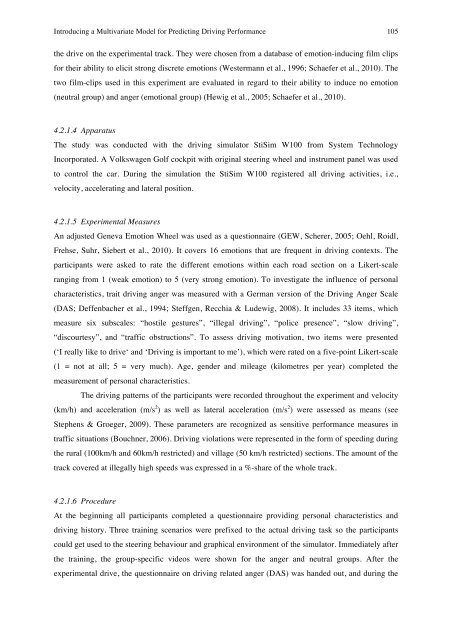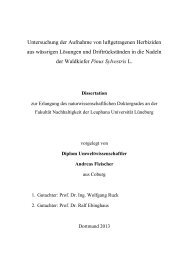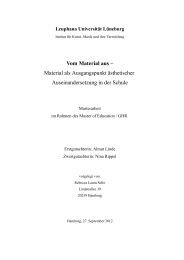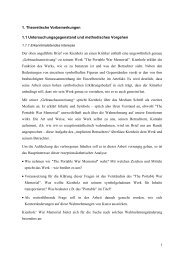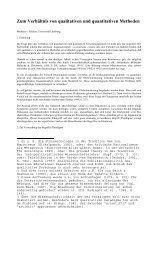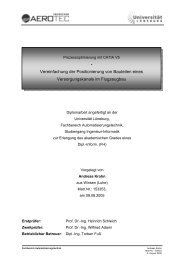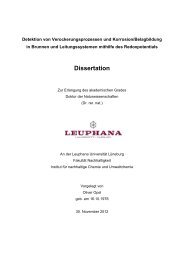Determinants of Emotional Experiences in Traffic Situations ... - OPUS
Determinants of Emotional Experiences in Traffic Situations ... - OPUS
Determinants of Emotional Experiences in Traffic Situations ... - OPUS
Create successful ePaper yourself
Turn your PDF publications into a flip-book with our unique Google optimized e-Paper software.
Introduc<strong>in</strong>g a Multivariate Model for Predict<strong>in</strong>g Driv<strong>in</strong>g Performance 105<br />
the drive on the experimental track. They were chosen from a database <strong>of</strong> emotion-<strong>in</strong>duc<strong>in</strong>g film clips<br />
for their ability to elicit strong discrete emotions (Westermann et al., 1996; Schaefer et al., 2010). The<br />
two film-clips used <strong>in</strong> this experiment are evaluated <strong>in</strong> regard to their ability to <strong>in</strong>duce no emotion<br />
(neutral group) and anger (emotional group) (Hewig et al., 2005; Schaefer et al., 2010).<br />
4.2.1.4 Apparatus<br />
The study was conducted with the driv<strong>in</strong>g simulator StiSim W100 from System Technology<br />
Incorporated. A Volkswagen Golf cockpit with orig<strong>in</strong>al steer<strong>in</strong>g wheel and <strong>in</strong>strument panel was used<br />
to control the car. Dur<strong>in</strong>g the simulation the StiSim W100 registered all driv<strong>in</strong>g activities, i.e.,<br />
velocity, accelerat<strong>in</strong>g and lateral position.<br />
4.2.1.5 Experimental Measures<br />
An adjusted Geneva Emotion Wheel was used as a questionnaire (GEW, Scherer, 2005; Oehl, Roidl,<br />
Frehse, Suhr, Siebert et al., 2010). It covers 16 emotions that are frequent <strong>in</strong> driv<strong>in</strong>g contexts. The<br />
participants were asked to rate the different emotions with<strong>in</strong> each road section on a Likert-scale<br />
rang<strong>in</strong>g from 1 (weak emotion) to 5 (very strong emotion). To <strong>in</strong>vestigate the <strong>in</strong>fluence <strong>of</strong> personal<br />
characteristics, trait driv<strong>in</strong>g anger was measured with a German version <strong>of</strong> the Driv<strong>in</strong>g Anger Scale<br />
(DAS; Deffenbacher et al., 1994; Steffgen, Recchia & Ludewig, 2008). It <strong>in</strong>cludes 33 items, which<br />
measure six subscales: “hostile gestures”, “illegal driv<strong>in</strong>g”, “police presence”, “slow driv<strong>in</strong>g”,<br />
“discourtesy”, and “traffic obstructions”. To assess driv<strong>in</strong>g motivation, two items were presented<br />
(‘I really like to drive‘ and ‘Driv<strong>in</strong>g is important to me’), which were rated on a five-po<strong>in</strong>t Likert-scale<br />
(1 = not at all; 5 = very much). Age, gender and mileage (kilometres per year) completed the<br />
measurement <strong>of</strong> personal characteristics.<br />
The driv<strong>in</strong>g patterns <strong>of</strong> the participants were recorded throughout the experiment and velocity<br />
(km/h) and acceleration (m/s 2 ) as well as lateral acceleration (m/s 2 ) were assessed as means (see<br />
Stephens & Groeger, 2009). These parameters are recognized as sensitive performance measures <strong>in</strong><br />
traffic situations (Bouchner, 2006). Driv<strong>in</strong>g violations were represented <strong>in</strong> the form <strong>of</strong> speed<strong>in</strong>g dur<strong>in</strong>g<br />
the rural (100km/h and 60km/h restricted) and village (50 km/h restricted) sections. The amount <strong>of</strong> the<br />
track covered at illegally high speeds was expressed <strong>in</strong> a %-share <strong>of</strong> the whole track.<br />
4.2.1.6 Procedure<br />
At the beg<strong>in</strong>n<strong>in</strong>g all participants completed a questionnaire provid<strong>in</strong>g personal characteristics and<br />
driv<strong>in</strong>g history. Three tra<strong>in</strong><strong>in</strong>g scenarios were prefixed to the actual driv<strong>in</strong>g task so the participants<br />
could get used to the steer<strong>in</strong>g behaviour and graphical environment <strong>of</strong> the simulator. Immediately after<br />
the tra<strong>in</strong><strong>in</strong>g, the group-specific videos were shown for the anger and neutral groups. After the<br />
experimental drive, the questionnaire on driv<strong>in</strong>g related anger (DAS) was handed out, and dur<strong>in</strong>g the<br />
!


